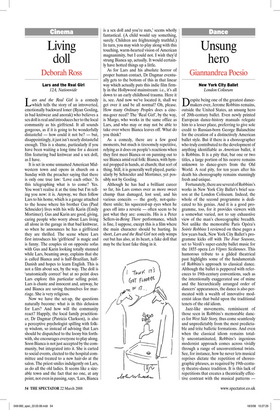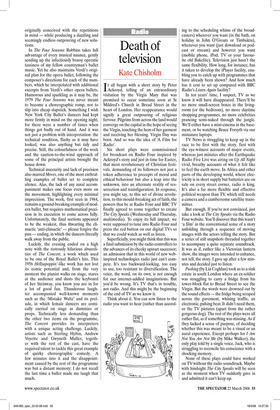Unsung hero
Giannandrea Poesio
New York City Ballet London Coliseum
Despite being one of the greatest dancemakers ever, Jerome Robbins remains, outside the United States, an unsung hero of 20th-century ballet. Even newly printed European dance-history manuals relegate him to a lesser place, preferring to give sole credit to Russian-born George Balanchine for the creation of a distinctively American ballet style. But if there is a choreographer who truly contributed to the development of anything identifiable as American ballet, it is Robbins. It is a pity that, bar one or two titles, a large portion of his oeuvre remains unknown to dance-goers from the Old World. A real pity, for ten years after his death his choreography remains stunningly fresh and unique.
Fortunately, there are several of Robbins’s works in New York City Ballet’s brief season at the London Coliseum. Indeed, the whole of the second programme is dedicated to his genius. And it is a good programme, too, for it provides viewers with a somewhat varied, not to say exhaustive view of the man’s choreographic breadth. Not unlike the memorable Paris Opéra’s Soirée Robbins I reviewed on these pages a few years back, New York City Ballet’s programme kicks off with The Four Seasons, set to Verdi’s super-catchy ballet music for the 1855 opera Les Vêpres Siciliennes. This humorous tribute to a gilded theatrical past highlights some of the fundamentals of Robbins’s approach to classical dance. Although the ballet is peppered with references to 19th-century conventions, such as the intentionally exaggerated use of mime and the hierarchically arranged order of dancers’ appearances, the dance is also permeated with a wealth of innovative modernist ideas that build upon the traditional tenets of the old idiom.
Jazz-like movements, reminiscent of those seen in Robbins’s memorable dances for West Side Story, thus come seamlessly and unpredictably from the most predictable and trite balletic formations. And even when the classical idiom remains totally uncontaminated, Robbins’s ingenious modernist approach comes across vividly through a range of unconventional twists. See, for instance, how he never lets musical reprises dictate the repetition of choreographic phrases, as required by 19th-century theatre-dance tradition. It is this lack of repetitions that creates a theatrically effective contrast with the musical patterns — originally conceived with the repetitions in mind — while producing a dazzling and seemingly endless outpouring of new solutions.
In The Four Seasons Robbins takes full advantage of every musical nuance, gently sending up the infectiously brassy operatic tastiness of my fellow countryman’s ballet music. Yet he also maintains Verdi’s original plan for the opera ballet, following the composer’s directions for each of the numbers, which he interpolated with additional excerpts from Verdi’s other opera ballets. Humorous and sparkling as it may be, the 1979 The Four Seasons was never meant to become a choreographic romp, nor to slip into cheap slapstick. Something I wish New York City Ballet’s dancers had kept more firmly in mind on the opening night, for there were a number of times when things got badly out of hand. And it was not just a problem with interpretation: the technical rendition, flashy as it may have looked, was also anything but tidy and precise. Still, the colourfulness of the work and the caution-to-the-wind approach of some of the principal artists brought the house down.
Technical insecurity and lack of precision also marred Moves, one of the most enthralling examples of ballet set to complete silence. Alas, the lack of any aural accompaniment makes one focus even more on the movement, highlighting every minimal imprecision. The work, first seen in 1984, remains a ground-breaking example of modern ballet, but requires mathematical precision in its execution to come across fully. Unfortunately, the final sections appeared to be the weakest, thus thwarting the climactic ‘anti-climactic’ — please forgive the pun — ending, in which the dancers literally walk away from the public.
Luckily, the evening ended on a high note with the riotously hilarious absurdities of The Concert, a work which used to be one of the Royal Ballet’s hits. This 1956 Hellzapoppin’-like work has not lost its comic potential and, from the very moment the pianist walks on stage, stares at the audience and dusts the keyboard of her Steinway, you know you are in for a lot of good fun. Thunderous laughter accompanied well-known moments such as the ‘Mistake Waltz’ and its prelude, in which female dancers are comically carried on stage as dummies or props. Technically less demanding than the other two items on the programme, The Concert provides its interpreters with a unique acting challenge. Luckily, artists such as Sterling Hyltin, Andrew Veyette and Gwyneth Muller, together with the rest of the cast, have the required talent to tackle this great example of quirky choreographic comedy. A few minutes into it and the disappointment caused by the rest of the programme was but a distant memory; I do not recall the last time a ballet made me laugh that much.



















































































 Previous page
Previous page